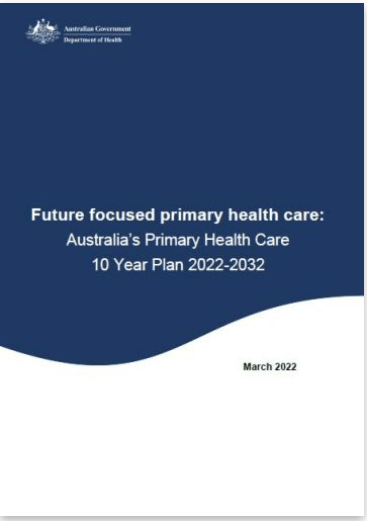“It is a time of significant health system pressure and with that pressure, comes the opportunity for change” – Larter Consulting
Earlier this year, the federal government released its 10-year roadmap for primary health care services in Australia, Australia’s Primary Health Care 10 Year Plan 2022–2032. The plan provides an agenda for primary health care reform over the next decade, serving as a framework for Government decision-making at each step along the way.
Drawing from the plan, we are going to shed light on how the future of primary health care might look like and how our team at Larter can help navigate changes to come over the coming years.
The plan builds on some of the foundational reform activities already underway, including:
- MBS-funded telehealth
- Greater focus on allied health and nursing as vital workforces, including strategies such as the Nurse Practitioner 10 Year Plan
- Access to appropriate after-hours care
- More equitable access to services for groups at higher risk of missing out on care.
3 priority reform streams for future-focused health care
Building on the strong foundation laid out by the existing reform activities, the plan proposes three streams to focus reform activity and investment.
Stream 1: Optimising technology
Australia needs to accelerate exploring opportunities for technology to drive improvements in access, quality, value and integration. This should include safe and fit-for-purpose virtual health care, harnessing advances in health care technologies, and driving value through data-informed insights and digital integration.
Optimising technology has been an important focus of Larter’s recent projects. For example, in 2021, Larter worked with a remote hospital and health service in Queensland to undertake a comparative cost analysis and full evaluation of their Virtual Health Program. The program, implemented in Remote (Mount Isa) and Very Remote (Mornington Island) Queensland, aimed to improve outcomes for people living with chronic diseases such as diabetes, especially among people identifying as Aboriginal and Torres Strait Islander, utilising a remote patient monitoring system. This remote system allows the patient care team based in Mount Isa hospital to monitor metrics such as blood sugar levels, heart rate, blood pressure, and respond to any concerns identified by the system, allowing for early intervention.
Stream 2: Person-centred primary health care, supported by funding reform
The primary health care system needs to be financially supported to deliver value and quality rather than volume. The 10 Year Plan suggests reforms to general practice funding and using voluntary patient registration to drive change. Payments should incentivise quality and outcomes, with an increased focus on improving access to quality care in areas where outcomes are currently poor.
New funding models for primary care nursing and allied health are an important part of this strategy. Larter is currently working with services and commissioners to explore new models to:
- Boost multidisciplinary team-based care
- Improve access to primary health care in rural areas
- Improve access to appropriate care for people at risk of poorer outcomes, and
- Empower people to stay healthy and manage their own health care.
For example, Larter has just worked with community and health sector stakeholders to co-design a Community-Led Integrated Health Care Hub model, and accompanying commissioning strategy, for rural and regional Victoria.
Stream 3: Integrated care, locally delivered
Joint planning and collaborative commissioning are key to delivering local health service and system integration – at regional and at state levels. Planning and commissioning collaboratively will reduce silos, duplication and fragmented care.
Avoidable hospital presentations for over 65s provide an example of the value available through integrated care: there are opportunities to shift part of the 1.6 million emergency department (ED) presentations for over 65s (one-fifth of the total 7.8 million presentations) to be more appropriately and adequately supported in the community, through general practice.
Another example can be found in one of our current projects where Larter is undertaking financial consulting to understand the level of revenue optimisation and financial sustainability that could be achieved through a sub-regional single-employer model. In the context of this particular project, small rural communities have created a network of general practitioner and primary care services through sharing of doctors, nurses and administrative staff across the communities. This work may have implications for other communities looking to implement a similar single-employer model where there has been private GP primary care market failure.

Developing new, innovative and localised models of care
The 10 Year Plan aims to bring about major change over the next decade in the delivery of primary care and how people and communities are engaged.
At Larter, we are passionate about strengthening the primary care system. We translate the quadruple (and quintuple) aim and primary health care reform agendas into strategies on the ground that really work for commissioners, service providers and consumers alike.
“PHNs and local health networks approach us to help co-design, implement, measure outcomes and review their services and commissioning strategies. We work with service providers too, developing new and innovative models of care,” says Jo Grzelinska, Principal Consultant.
“We work nationally in rural and regional areas and understand the operational and workforce challenges. With the new 10-year plan focussing on allied health and nursing as vital workforces, we draw on our history of experience to assist with planning and developing business cases and strategies for the increased focus on these practitioners, such as Nurse Practitioner models.
“In the last 12 months, we have been working across a number of contexts to improve access to rural health care — including instances of market failure, new business models and community-led models – especially in eastern Australia.”
Contact us on 1800 527 837 or larter@larter.com.au to discuss your primary health care reform needs.
